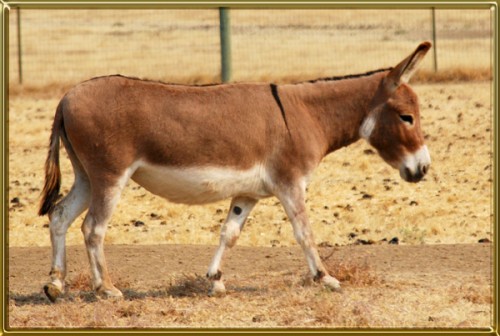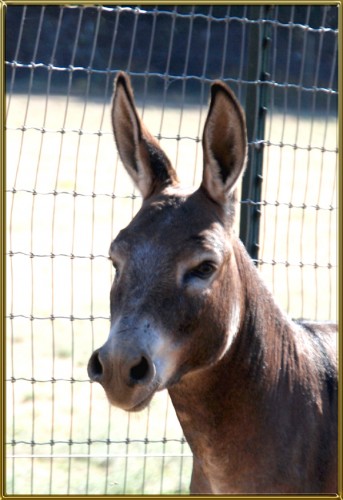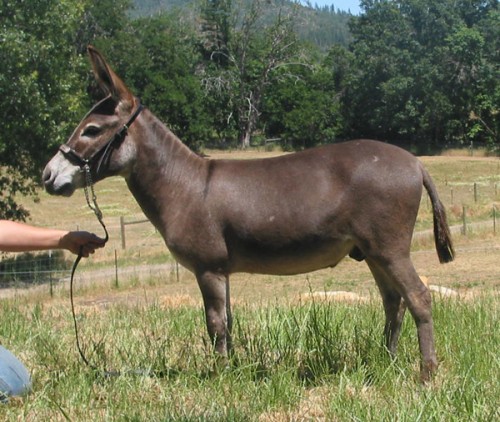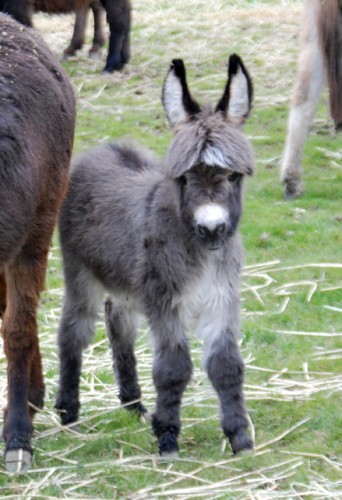written by Cindy Benson
2012
There are often times when I need to quickly evaluate the conformation of a donkey, such as when I travel, at a sale, or at a show. These donkeys may be out in a field wearing their winter shaggy coat or show clipped, in hand or at liberty. A good deal of the time I quietly make a judgment about the donkey while I am in conversation with it’s owner. I have created a system of studying a donkey that works for me. There are LOTS of excellent books written that can teach the intricacies of conformation; my system is a cursory evaluation only. I find that it helps me to evaluate conformation when I do it in an organized fashion.
The first thing I look at is the head. I want to see a big soft eye, and an appropriate length of head with a lot of character. A beautiful head is very important to me so if the donkey doesn’t have one my consideration of it is concluded. Next I look at the hooves. I will not purchase a club footed donkey and I check the hoof for the rings around it and shape that can suggest the donkey has been foundered. Then I check the donkey’s bite. This is easy to do with one finger while I snuggle the donkey’s head and I can usually accomplish this unnoticed by the owner thereby avoiding offending him/ her. I will not purchase a donkey for breeding with a bite off more than 1/8th inch.
Quite a lot of the donkeys I look at do not pass these first criteria but if he/she has I continue by studying the donkey from the side. I am looking for balance. I want to see thirds: the chest, mid-section, and hip should all be of about the same proportion, and look like they all should belong to the same animal! Some donkeys look like they could tip forward with slight provocation because the chest is big, the neck thick, and the head big while the hindquarter is slight. The donkey should have about the same depth of body as it has leg, however the desirability of this can depend on the proposed use of this animal. A performance donkey can move better with long legs and a longer mid-section comparatively. If the donkey has passed the criteria so far he is worth a little more of my time.
Now I look for a fine throatlatch, an appropriate length of neck, a high tie-in of the neck at the shoulder and good definition of where the neck ends and the shoulder begins. This is especially important for a driving donkey because a short, thick neck with a low tie-in impedes movement.
When I look at the midsection of the donkey I would like to see a level top line with a strong loin. I also want to see the donkey tuck up a bit in the flank area. Again, thickness here impedes movement. I love a deep hip! When I look at the hip of a donkey I consider the length of the hip as well as it’s shape. I want to see an equal triangle of the knobby hip bone, the bone just below the tail, and the stifle. If I see this or close to it I continue.
I go to the front of the donkey and study the width of it’s chest and the quality of the front legs. What legs can show could be an article in itself but for my purpose here this is what I do. I picture a straight line drawn from the center of the front legs as they come out of the chest and through the knee, pastern and hoof. I hope to see as little deviation from this bisection as possible and it is up to me to decide how much deviation I am willing to tolerate. While I am at the front of the donkey I also look back across the top of the rump and off across the top of the tail. A good quality donkey will be round across the top of his rump; a poor quality donkey will have a steep angle from the spine and down to it’s sides.
Now I go to the back of the donkey and look at the width between it’s legs. The width should be the same for both the front legs and hind legs. Then I mentally draw the same straight line as I did for the front legs. Again, it is for me to decide how much deviation I am comfortable with. I also look at the point of the hip bones to the two small bony knobs on each side of the tail and draw a visual straight line between them. I want this to be a wide angle because a narrow opening at the pelvis is a problem for safe foaling, and it is not as strong functionally.
This concludes my cursorily evaluation but not my decision about purchase. Now I will consider the pedigree of this donkey and how it will mesh in my herd. There are often many ways to do things right so please remember this is just what works for me. I hope it will help you too!



